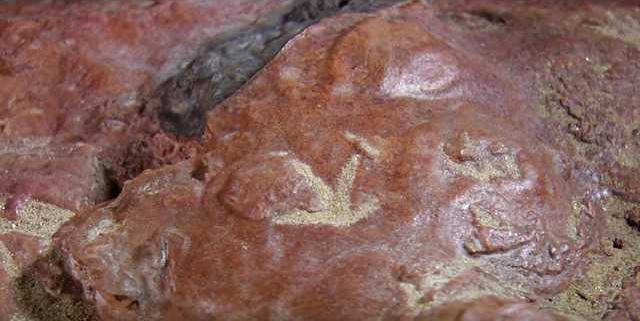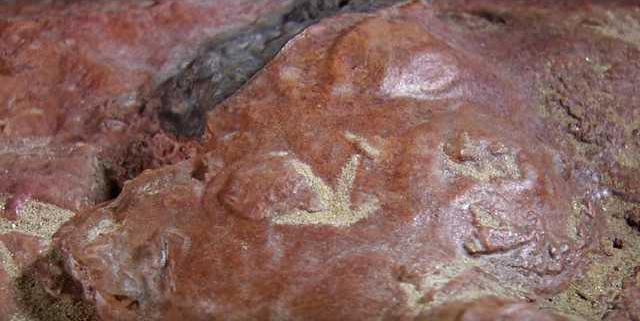Close to 70 dinosaur and mammal tracks were discovered outside of NASAs Goddard Space Flight Center near Washington, D.C., according to a new research paper published in Scientific Reports.
Researchers first discovered the tracks in 2012 when dinosaur track expert Ray Stanford dropped his wife off at the flight center, according to a NASA press release.
He noticed a rock behind the building and then discovered a 12-inch-wide dinosaur track on a slab of sandstone the size of a dining table, which was covered in around 70 additional footprints made more than 100 million years ago, according to Time magazine.
The footprints were later discovered to be from massive dinosaurs and some smaller mammals.
According to NASA, the prints likely came around the same time in the Cretaceous period.
NASA discovered close to 26 tracks there, which means the flight center has one of the highest concentration of mammals in one location.
The concentration of mammal tracks on this site is orders of magnitude higher than any other site in the world, Martin Lockley, co-author on the Scientific Reports paper, said in the NASA release.
I dont think Ive ever seen a slab this size, which is a couple of square meters, where you have over 70 footprints of so many different types, he said, according to Time. This is the mother lode of Cretaceous mammal tracks.
Though the researchers were impressed with the dinosaur tracks, it is the collection of mammal tracks that make the slab significant, according to NASA.
Lockley said in NASAs press release that the findings unveil hints about what other wildlife may have existed in the Maryland area during the Cretaceous period.
This could be the key to understanding some of the smaller finds from the area, so it brings everything together, Lockley said. "This is the Cretaceous equivalent of the Rosetta stone."
Dinosaur research has made big news in the past couple of weeks. Last week, scientists announced the discovery of a new dinosaur in the Egyptian desert, according to BBC.
The discovery offered a glimpse into Egypts history of dinosaurs. Scientists rarely find dinosaurs in Africa.
Africa remains a giant question mark in terms of land-dwelling animals at the end of the Age of Dinosaurs, Eric Gorscak, another co-author of the recent study said, according to Time. Mansourasaurus helps us address longstanding questions about Africas fossil record and paleobiology.
Researchers first discovered the tracks in 2012 when dinosaur track expert Ray Stanford dropped his wife off at the flight center, according to a NASA press release.
He noticed a rock behind the building and then discovered a 12-inch-wide dinosaur track on a slab of sandstone the size of a dining table, which was covered in around 70 additional footprints made more than 100 million years ago, according to Time magazine.
The footprints were later discovered to be from massive dinosaurs and some smaller mammals.
According to NASA, the prints likely came around the same time in the Cretaceous period.
NASA discovered close to 26 tracks there, which means the flight center has one of the highest concentration of mammals in one location.
The concentration of mammal tracks on this site is orders of magnitude higher than any other site in the world, Martin Lockley, co-author on the Scientific Reports paper, said in the NASA release.
I dont think Ive ever seen a slab this size, which is a couple of square meters, where you have over 70 footprints of so many different types, he said, according to Time. This is the mother lode of Cretaceous mammal tracks.
Though the researchers were impressed with the dinosaur tracks, it is the collection of mammal tracks that make the slab significant, according to NASA.
Lockley said in NASAs press release that the findings unveil hints about what other wildlife may have existed in the Maryland area during the Cretaceous period.
This could be the key to understanding some of the smaller finds from the area, so it brings everything together, Lockley said. "This is the Cretaceous equivalent of the Rosetta stone."
Dinosaur research has made big news in the past couple of weeks. Last week, scientists announced the discovery of a new dinosaur in the Egyptian desert, according to BBC.
The discovery offered a glimpse into Egypts history of dinosaurs. Scientists rarely find dinosaurs in Africa.
Africa remains a giant question mark in terms of land-dwelling animals at the end of the Age of Dinosaurs, Eric Gorscak, another co-author of the recent study said, according to Time. Mansourasaurus helps us address longstanding questions about Africas fossil record and paleobiology.








